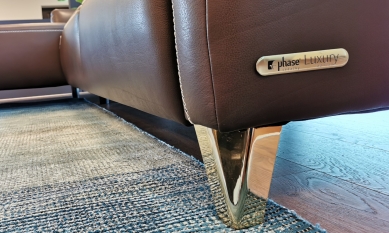
Furniture labeling 9× different: Designer, elegant, durable
What is specific about labeling for furniture? It must be subtle, so as not to draw attention away from the piece itself, such as a chair, table, or kitchen countertop. At the same time, it should be elegant and of high quality to keep up with the furniture. Take a look at the labels created by Czech manufacturers of 3D labels and gather inspiration for your project.
Choosing an inventory audit label is a routine for many furniture makers. In contrast, a marketing label bearing the brand name or product series serves as the proverbial cherry on top, aimed at refining the entire product. Besides its visual aspect, this label has another important function.
"Design labeling reminds the user where the furniture was purchased. Whether it’s at home in the living room, in a favorite café, or perhaps in the office, the labeling should last throughout the furniture's lifetime, serving as a guide for future purchases," explains Martin Uhrinec, the sales director of RATHGEBER, which specializes in producing high-quality technical as well as design labeling.
Each material has its specifics. Aluminum labels are durable and elegant. If the label is to be exposed to really demanding conditions, it is better to rely on a stainless steel label. Plastic labels are an option for indoor furniture, where direct sunlight and moisture are not a concern. "Regarding aesthetics, the choice of material depends on the client. We make the selection easier with dozens of samples, which help them better visualize how the result will look," adds Martin Uhrinec from RATHGEBER.
Choosing an inventory audit label is a routine for many furniture makers. In contrast, a marketing label bearing the brand name or product series serves as the proverbial cherry on top, aimed at refining the entire product. Besides its visual aspect, this label has another important function.
"Design labeling reminds the user where the furniture was purchased. Whether it’s at home in the living room, in a favorite café, or perhaps in the office, the labeling should last throughout the furniture's lifetime, serving as a guide for future purchases," explains Martin Uhrinec, the sales director of RATHGEBER, which specializes in producing high-quality technical as well as design labeling.
Label material: Is metal or plastic better?
It depends on many factors: What material is the furniture made of? Should the label appear elegant, modern, or classic? Will it be attached to a designer chair, shelf, or interior door? "It also depends on the conditions the furniture will be exposed to. The durability requirements of garden furniture will be diametrically different from those of a leather sofa. This basic choice should be made by an expert in design labeling," says Martin Uhrinec.Each material has its specifics. Aluminum labels are durable and elegant. If the label is to be exposed to really demanding conditions, it is better to rely on a stainless steel label. Plastic labels are an option for indoor furniture, where direct sunlight and moisture are not a concern. "Regarding aesthetics, the choice of material depends on the client. We make the selection easier with dozens of samples, which help them better visualize how the result will look," adds Martin Uhrinec from RATHGEBER.
Three mistakes in label design. Are you making them too?
- First the furniture, then the label: Especially with designer furniture, the customer should approach labels as an inseparable part of the furniture. Not as something that is created ex-post as a mandatory, forced part. Then it is very noticeable and appears artificial.
- The boundary between functionality and miniaturization: Miniature inscriptions and logos, a very fine detail that should be subtle, interesting, visible, attractive, inconspicuous..., but at the same time must endure on the furniture forever. Experts can make precise labels, but unfortunately not miracles.
- Lack of courage: Companies often play it safe with color combinations when designing labeling, using surface enhancements for 3D labels, or embossing details. The result is either too bulky or, on the contrary, very inconspicuous designs.
Get inspired by companies that have invested in the quality of Czech labels
Take a look at 3D labels created by Czech manufacturers of labeling. Their common denominator is top-notch quality along with the perfect work of specialists, which enhances the uniqueness of the furniture.The English translation is powered by AI tool. Switch to Czech to view the original text source.








0 comments
add comment












